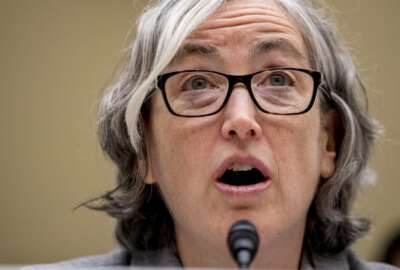
Sammies finalist organized HUD voucher program to keep foster children who age out off the streets
Foster children eventually grow up. Some 20,000 reach 18 years of age each year and then they're on their own. This HUD initiative can help.
Best listening experience is on Chrome, Firefox or Safari. Subscribe to Federal Drive’s daily audio interviews on Apple Podcasts or PodcastOne.
Foster children eventually grow up. Some 20,000 reach 18 years of age each year and then they’re on their own. Concerned that many of them ended up homeless, Ryan Jones organized a federal housing voucher program. He is the deputy director for the Housing Voucher Management and Operations division at the Department of Housing and Urban Development, and a finalist in this year’s Service to America Medals program along with colleagues Michelle Daniels and Charles Eldridge. Jones spoke more about their work to Federal Drive with Tom Temin.
Interview transcript:
Tom Temin: Mr. Jones, good to have you on.
Ryan Jones: Great to be with you, Tom.
Tom Temin: And we should acknowledge you are part of a group award and you are joined in the award with Michelle Daniels and Charles Eldridge, also in that program, that could not join us this morning. But tell us what you’re doing here. What is the situation you’re trying to address here with foster children that have to, I guess, leave the foster homes at the age of 18?
Ryan Jones: Yeah, maybe a little background would be helpful for your audience. So how it got started is HUD took a meeting in March of 2019 with current foster youth and foster youth alumni from Ohio, with some of those participants being young people still in high school. And these young people were brave enough to share their story on the challenges that foster youth may face when they age out of foster care. The problem that we want to solve and the one we’re working together to discuss was, as you mentioned, the high prevalence of homelessness experienced by youth that have aged out of the foster care, a number as high as 25% experienced homelessness by the time they reach their mid 20s. In their story, they shared how critical it is for young people like themselves to have access to decent, safe and affordable housing. And they shared a plan for a new model for making housing choice vouchers targeted to youth available in communities across the country. Their plan was the bedrock of what would become the foster youth independence initiative that HUD launched in the summer of 2019.
Tom Temin: Got it. And just a question about where they are emerging from in foster care. Because isn’t it sometimes that they are with families. And do they have to leave at 18? People with their own children often let them live at home until they’re independent financially. What’s going on in the foster system that’s causing this?
Ryan Jones: It can be a multitude of things. I’m not an expert in the child welfare space, I’m a houser, but young people that are presenting to us into the doors of our housing agencies are coming to the housing agencies having a myriad of experiences in the child welfare space. Many of them may have had their successful experience in the child welfare space, but just given the challenges of independence at the point that they have left foster care that they just needed this additional helping hand and housing, they needed a platform so that they could reach and achieve their goals towards their path to self sufficiency.
Tom Temin: Sure. And in conceiving this program, did it require legislation to enable HUD to spend money on it?
Ryan Jones: Yes. And thankfully, the young people that we met with, they realized that HUD already had the statutory authority that needed to stand up this program. What we did after meeting with these young people is took their message to heart and looked at our statutes and the flexibilities that we have in the fungibility with some of our funding and found a way to make it work in the first year. This was really a trial when we first launched this program. We were able to tap into and using the flexibilities that Congress had provided us, to stand up this program. And since that initial year, Congress in the last two appropriations have specifically provided funding for foster youth to provide housing choice vouchers for this population, given the success that we had in the first year of the program.
Tom Temin: We’re speaking with Ryan Jones, he’s deputy director for the Housing Voucher Management and Operations Division at Housing and Urban Development, and also a finalist in this year’s Service to America Medals Program. And just briefly tell us how the program works. How do you get in touch with the people that might need the vouchers or how do they find HUD – and then what happens?
Ryan Jones: Sure, so a little background on what is the Foster Youth to Independence. So it’s a HUD program promoting partnerships between public housing agencies and public child welfare agencies, where a community is able to request housing choice vouchers to serve youth under the age of 25 with the history of child welfare involvement that are at risk of experiencing homelessness. So the idea is to set these young people on a path to reach their education and employment goals, and ultimately on a path to self sufficiency. These targeted housing choice vouchers, they allow the participants to find their own housing on the private market, or the funding provided by HUD to the housing agency makes up the difference in what the young person may pay in rent and what the actual rent is so that a young person is generally paying no more than 30% of their income towards rent. So the front door to this program is your local child welfare agency that many of the young people that are still in the child welfare program are engaged in or for those that no longer have a connection to the child welfare agency, the front door can be myriad, it can be reaching out to a local public housing agency, or reaching out to local homeless service providers that can put that young person in connection with the child welfare agency that can help start that process.
Tom Temin: It sounds like some of the success of the program depends on making sure that those public housing agencies or the service providers are fully aware of this, should the person present themselves to them.
Ryan Jones: Yes, absolutely. When we launched in the summer of 2019, not only that we put a lot of work into designing a program that is easy to access that works for communities. But we also spend a lot of time thinking about how we get the message out to communities about this opportunity. And one of the co-recipients of the Sammies nomination, Charles Eldridge, is our cheerleader for the Foster Youth to Independence initiatives in our HUD regions. And it’s because of the work of our Office of Field Operations, those who are boots on the ground in the local communities that they are reaching out to and working with, and collaborating with our housing agencies, with our child welfare agencies, with our other partners that are critical to identifying this opportunity and making this work at a community level.
Tom Temin: And I found that many times the Sammies awardees are people that have a particular passion for the work, it’s not just a job. Tell us about yourself, how you got into this, and your interest in housing, the people that are sometimes having trouble getting housing.
Ryan Jones: Yeah. Like so many that find themselves in public service, I was driven by the mission of HUD and specifically the mission of the housing choice voucher programs, the ability to provide housing choice voucher to a family to be able to find safe, decent, affordable housing. I can’t imagine a better mission and effort to be working on, so like many I was driven to public service and the conversations that I have with the families that are recipients of this assistance in the communities that benefit from having this resource to ensuring that our low and very low income families have a place to call home. These are critical members of every community, and they deserve to have a place to call home. And that’s what drives us at HUD is making sure that we have a program that works for the recipients. And what our moving forward is just continuing to open and keep that dialogue with especially the recipients of FYIs, to make sure we have a program that’s working for them. That’s how this program came about is by listening to those with lived experiences. And I think that’s what will continue to drive us moving forward.
Tom Temin: And do you have any idea of the numbers you have served so far in the two years the program has been operating?
Ryan Jones: So far, we’ve served more than 1,000 families, more than $10 million, and three dozen states this program is available – and that’s just the start. Every day, every month we’re making new awards, we’re reaching out to more communities that may be interested in administering this assistance, and expanding access to this program for those that would be eligible and interested.
Tom Temin: Sounds like a good investment. Ryan Jones is deputy director for the Housing Voucher Management and Operations Division at Housing and Urban Development, and along with HUD’s Michelle Daniels and Charles Eldridge, a finalist in this year’s Service to America Medals Program. Thanks so much for joining me.
Ryan Jones: Thank you, Tom.
Copyright © 2025 Federal News Network. All rights reserved. This website is not intended for users located within the European Economic Area.
Tom Temin is host of the Federal Drive and has been providing insight on federal technology and management issues for more than 30 years.
Follow @tteminWFED





